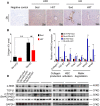High-Intensity Interval Training Attenuates Ketogenic Diet-Induced Liver Fibrosis in Type 2 Diabetic Mice by Ameliorating TGF-β1/Smad Signaling
- PMID: 33192083
- PMCID: PMC7656782
- DOI: 10.2147/DMSO.S275660
High-Intensity Interval Training Attenuates Ketogenic Diet-Induced Liver Fibrosis in Type 2 Diabetic Mice by Ameliorating TGF-β1/Smad Signaling
Abstract
Objective: Ketogenic diet (KD) and high-intensity interval training (HIIT) have preclinical benefits for type 2 diabetes (Db). However, the health risks of long-term KD use in diabetes should be ascertained and prevented. We hypothesized that KD-induced liver fibrosis in type 2 diabetic mice could be ameliorated by HIIT.
Methods: Streptozotocin-induced type 2 diabetic mice were divided into high-fat diet (HFD) control (Db+HFD+Sed), KD control (Db+KD+Sed), HFD coupled with HIIT (Db+HFD+HIIT), and KD coupled with HIIT (Db+KD+HIIT) groups (n=6, per group). Control mice were kept in sedentary (Sed), while HIIT group mice underwent 40-minute high-intensity interval training three alternate days per week. After 8-week intervention, the indicators of body weight and insulin resistance, oxidative stress markers, hepatic fibrosis, genetic and protein expression of related pathways were tested.
Results: We found that fasting blood glucose level was reduced in the Db+HFD+HIIT, Db+KD+Sed, and Db+KD+HIIT groups. Insulin sensitivity was increased in diabetic mice of these groups, whereas ROS levels were decreased in mice that underwent HIIT. The immunohistochemical staining of liver, serum index, and hepatic parameters of diabetic mice in the KD group revealed liver fibrosis, which was significantly attenuated by HIIT. Besides, these effects of HIIT were the outcome of hepatic stellate cell's inactivation, reduced protein expression of matrix metalloproteinases and tissue inhibitor of metalloproteinases, and the inhibition of TGF-β1/Smad signaling.
Conclusion: KD had a profound fibrotic effect on the liver of type 2 diabetic mice, whereas HIIT ameliorated this effect. KD did not show any apparent benefit as far as glucose tolerance and homeostasis were concerned. Concisely, our results demonstrated that KD should be coupled with HIIT for the prevention and preclinical mitigation of type 2 diabetes.
Keywords: ROS; TGF-β1/Smad signal; diabetes; hepatic fibrosis; high-intensity interval training; ketogenic diet.
© 2020 Zhang et al.
Conflict of interest statement
Dr. Yi Sun and Dr. ShuZhe Ding report grants from the National Natural Science Foundation of China, during the conduct of the study. The authors report no other potential conflicts of interest for this work.
Figures




Similar articles
-
High-intensity interval training induces renal injury and fibrosis in type 2 diabetic mice.Life Sci. 2023 Jul 1;324:121740. doi: 10.1016/j.lfs.2023.121740. Epub 2023 Apr 27. Life Sci. 2023. PMID: 37120014
-
Effects of exercise intensity and diet on cardiac tissue structure and FGF21/β-Klotho signaling in type 2 diabetic mice: a comparative study of HFD and HFD + STZ induced type 2 diabetes models in mice.Diabetol Metab Syndr. 2025 Jan 6;17(1):4. doi: 10.1186/s13098-024-01541-3. Diabetol Metab Syndr. 2025. PMID: 39757236 Free PMC article.
-
Beneficial alterations in body composition, physical performance, oxidative stress, inflammatory markers, and adipocytokines induced by long-term high-intensity interval training in an aged rat model.Exp Gerontol. 2018 Nov;113:150-162. doi: 10.1016/j.exger.2018.10.006. Epub 2018 Oct 9. Exp Gerontol. 2018. PMID: 30308288
-
High-intensity interval training attenuates impairment in regulatory protein machinery of mitochondrial quality control in skeletal muscle of diet-induced obese mice.Appl Physiol Nutr Metab. 2024 Feb 1;49(2):236-249. doi: 10.1139/apnm-2023-0286. Epub 2023 Oct 18. Appl Physiol Nutr Metab. 2024. PMID: 37852013
-
Integrative Strategies for Preventing and Managing Metabolic Syndrome: The Impact of Exercise and Diet on Oxidative Stress Reduction-A Review.Life (Basel). 2025 May 8;15(5):757. doi: 10.3390/life15050757. Life (Basel). 2025. PMID: 40430185 Free PMC article. Review.
Cited by
-
The Effects of Different Types of Exercise on Pulmonary Inflammation and Fibrosis in Mice with Type 2 Diabetes Mellitus.Cells. 2025 Jul 4;14(13):1026. doi: 10.3390/cells14131026. Cells. 2025. PMID: 40643547 Free PMC article.
-
Ketogenic Diet Suppressed T-Regulatory Cells and Promoted Cardiac Fibrosis via Reducing Mitochondria-Associated Membranes and Inhibiting Mitochondrial Function.Oxid Med Cell Longev. 2021 Apr 19;2021:5512322. doi: 10.1155/2021/5512322. eCollection 2021. Oxid Med Cell Longev. 2021. PMID: 33959215 Free PMC article.
-
Comparison Between the Effect of Mid-Late-Life High-Intensity Interval Training and Continuous Moderate-Intensity Training in Old Mouse Hearts.J Gerontol A Biol Sci Med Sci. 2025 Apr 7;80(5):glaf025. doi: 10.1093/gerona/glaf025. J Gerontol A Biol Sci Med Sci. 2025. PMID: 39928548 Free PMC article.
-
Mitochondria-associated membranes contribution to exercise-mediated alleviation of hepatic insulin resistance: Contrasting high-intensity interval training with moderate-intensity continuous training in a high-fat diet mouse model.J Diabetes. 2024 Apr;16(4):e13540. doi: 10.1111/1753-0407.13540. J Diabetes. 2024. PMID: 38599845 Free PMC article.
-
Moderate Treadmill Exercise Alleviates NAFLD by Regulating the Biogenesis and Autophagy of Lipid Droplet.Nutrients. 2022 Nov 20;14(22):4910. doi: 10.3390/nu14224910. Nutrients. 2022. PMID: 36432597 Free PMC article.
References
LinkOut - more resources
Full Text Sources
Miscellaneous

